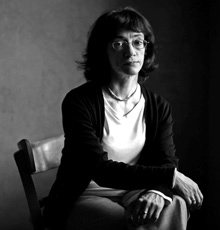The 50th Warsaw Autumn remains true to its traditions: the festival’s programme includes pianists Rūta and Zbignevas Ibelhauptas, who will play
Osvaldas Balakauskas’
Movimenti II (2007) and
Bronius Kutavičius’
Debate with a Stranger (1982), both works for two pianos and tape. However, probably the most solid Lithuanian accent in this year’s programme falls on to the symphonic piece
riva fiume sinfonia composed by
Onutė Narbutaitė at the commission of the festival, which is to be performed on 24th September by Sinfonia Varsovia, under Christopher Lyndon-Gee.
It was no coincidence that Onutė Narbutaitė was commissioned to compose a work for the anniversary festival: Polish musicians highly rank the creative individuality of the composer and her tight relationship with both European and Lithuanian cultural tradition, non-hermetic language and radiating 'natural beauty' of her music. (Andrzej Chłopecki)
Onutė Narbutaitė: “I received a commission for a 20 minute musical piece, but I did not feel like writing a single-part composition, but rather a symphony-like piece.” She did not want to title the composition the Fourth Symphony and came up with a more metaphorical title for the piece. “In the contemporary music, the imitation of diverse natural phenomena has become especially typical, however, in this piece both the river and the shore stand for more poetic and mythical concepts. I had in mind the mythical Styx or Lethe – a certain metaphorical situation of a human being. Although the music is indeed fairly fluctuating, separate images seem to dive out of each other and different sections flow out of each other.”
According to the composer, the new piece has the characteristics of a classical symphony, when separate sections differ as contrasting images. Like most works by Onutė Narbutaitė, this piece also distinguishes itself for the clear idea and proportional form: three different moods and structural sections of the piece clearly differ from each other, each lasting twice shorter than the preceding one.
Onutė Narbutaitė: “It is the major part of the work (extending to more than half of the entire duration) that resembles a symphony – it is more energetic, more thrusting, and it contains certain symphonism. For me it associates with space, intensity, a sense of freedom. Sometimes it is like a light-weight flight and sometimes like a powerful dream – with “flags and swords”.
The middle section is very chamber-like, as a separation or singleness of different instruments – I would say it is highly introspective. Here an utterly different texture prevails – delicate, fragile and with a different sounding resembling that of the chamber ensemble. This part was lived through; it was composed with extreme concentration, when the technique to be used was no longer important. Although, it takes up less time in terms of duration, this part is of greatest importance to me. It is like a silent climax before the decline. A journey of a lonely soul onto a different shore.
The closing section resembles a coda, with much brass and deep tones. Frankly speaking, I have planned a more abstract ending, which would probably be more pleasing to fans of diverse abstract contemporary music (well, you always dispute when you write, you have plenty of time). However, as one teacher at the conservatory used to say “Spanish character has crept in against the will of the composer.” That is how I naturally produced a third-interval moving in half-steps, coming from the opening section and a light involuntary reference to Bach appeared in the end. I took the liberty to leave it in.”
The new symphonic opus is not only a constant discussion with different “rules of decency” of the present day music and a dialogue with symphonic music tradition, but also a replenishment and continuation of own symphonic writing experience. In her Second Symphony (2001), the composer baldly used explicated romantic gestures, clearly expressed tonality and more vivid melos, while the piece La Barca (2005) is much more dissonant, with highly differentiated and fragile texture, cold timbres and melody that appears to be scattered and not transforming into a clearer rhetoric. How is the new work different?
Onutė Narbutaitė: “In comparison to La Barca, the new piece is very light in colour; it has many augmented triads, light harmonies and high registers. In particular, the opening section contains many contrasts between outright unisons and complicated harmonic episodes and thick textures. La Barca does not have concrete melody altogether, while the new piece has it, even though it is much more abstract than in the Second Symphony, which probably is more like my earlier works. Here tonal harmonies are also quite visible, but there are also many more chromatic movements, glissandi, etc. Of course, it is in a way fairly hackneyed in contemporary music, but I have attempted to obtain new harmonic progressions matching them up with specific harmony. Here are many strings, but they do not play such romantic and expressive role and the second section is based on oboe and bassoon solo. After a long while I have returned the piano to the orchestra, which is used for colouristic effect and is verging towards percussion section. By the way, the number of percussion instruments is significantly reduced.”
This, just like many other symphonic scores by Onutė Narbutaitė, resembles a very detailed graphical artwork – separate instrumental parts are highly differentiated and nuanced, abundant with dynamic and other articulative indications. The flexibility and rhythmic whimsicality of these textures, as well as their dynamic flickering and shading come to life only in the arms of attentive performers, who are capable of reading and conveying the modal nuances of this music without losing the sense of integrity.
Daiva Parulskienė

